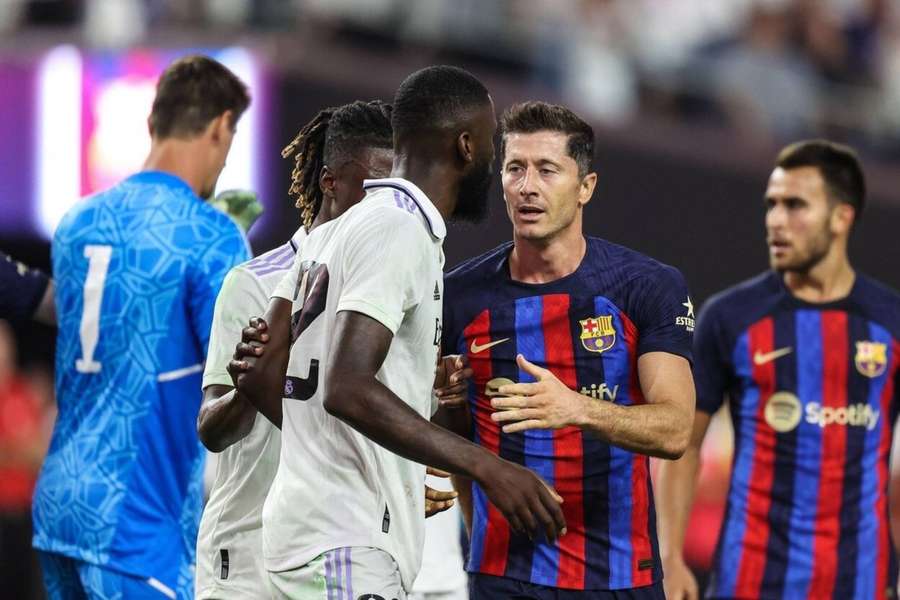Real v Barcelona: What could the two rivals do to catch each other off guard?

Real Madrid's attack
Key name: Vinícius Junior. The Brazilian winger has been the central figure of the "White Ballet" in recent seasons and a large number of attacking forays go through the left side that he floats around in. His main partner in creating scoring chances is Karim Benzema (34), but this season (also thanks to the injury of the Frenchman) his one-year-younger compatriot Rodrygo has also started to work closely with him.
The fact that these two players are currently driving Real's offensive is confirmed by the statistics of offensive actions per 90 minutes. Both of them score around seven, while the third most active Real player has less than four in this respect. They are also the most active dribblers on the team. In addition, the total of goals and assists shows that the Brazilian duo have a hand in 57.9% of the goals scored by the club from the capital in La Liga.
An important support for the offensive aces is Toni Kroos (32). The former German international is primarily responsible for moving the ball into the final third. He sends well over 20 passes per game to this part of the pitch, with second-placed Aurélien Tchouaméni (22) notching up eight. Kroos also leads the whole of La Liga in this discipline. And when the former Bayern player doesn't play, it has a negative impact on the number of passes the Royal Club sends into the attacking part of the pitch.
Barcelona's attack
It's the opposition's passes into the final third that are more evenly distributed. Unlike its biggest rival, it has six players in its team who notch up at least 10 such passes per game. However, the same cannot be said for goals, which are mainly the responsibility of Robert Lewandowski (34). He has scored 11 of Barcelona's 20 goals in the Spanish top flight.
Barca mainly enter the penalty through the right side of the pitch. Either Ousmane Dembele (25) or Raphinha (25) operates on this wing. Both of the aforementioned players pass into the penalty area the most out of the whole team, which is documented by the number of crosses. Barcelona have already sent 75 crosses from the right side this season, while only 50 from the left. In fact, the wingers on the left (Ferran Torres (22) and Ansu Fati (19)) hardly cross or pass into the box. This is mainly mainly taken care of by Jordi Alba (33).
However, when it comes to creating dangerous chances around the opponent's goal, we cannot forget the product of Barcelona's La Masia named Pedri. The 19-year-old is one of the best in La Liga in terms of passing through the opposition's defensive line. In total, he has already hit 15 and has an average of 2.37 per game. In second assists, there is no one better among the Spanish elite than this Blaugranas youngster.
Defence
Barcelona can also boast a great defensive record, having conceded only once in eight games in the Spanish league. Real, on the other hand, have kept a clean sheet only once. Carlo Ancelotti's side have a different defensive approach and press less. This can be demonstrated by PPDA (passes per defensive action), the number of passes exchanged by the opponent in the first 60% of the pitch before any defensive action is taken. The smaller the number, the more intense the offence.
While Barcelona's number shines at 6.71, Real's number of 10.66 is more towards the average. Also interesting, is the indicator of defensive duels, because Ancelotti's squad is well behind the rest of La Liga. The difference between Madrid's total and the second worst team in this statistical indicator is less than nine duels per game. There is almost the same difference between the penultimate team and the third or fourth best.
The Catalans are much higher up in this regard. With a 65% success rate in defensive duels, they are even the leaders. They are greatly helped by another youngster in the midfield, Gavi. The 18-year-old footballer immediately pounces on the opponent after losing the ball and tries to take the ball away from him or interrupt his action. Among Barcelona players, he is the best in terms of defensive duels per 90 minutes, and the same goes for slips and fouls.
Second-half weakness
If Real should try to use anything to score a goal in El Clásico, it should be going into the second half. In fact, the period between the 46th and 60th minutes is the worst of the match for their opponent on Sunday. Barcelona produces only 0.23 xG in that time span. It is also the only part of the match in which the team from Catalonia is outshot by its opponent.
We can expect Barcelona to try to take advantage of Real's less pressing activity to control the match, and without the ball, they will try to attack in the offensive third of the pitch. It's Real that will be expected to have a midfield block and subsequent quick counter attacks by the offensive players, led by Vinícius.

